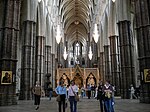Funeral of Diana, Princess of Wales

The funeral of Diana, Princess of Wales started on Saturday 6 September 1997 at 9:08 am in London, when the tenor bell of Westminster Abbey started tolling to signal the departure of the cortège from Kensington Palace. The coffin was carried from the palace on a gun carriage by riders of the King's Troop and escorted by mounted police, along Hyde Park to St James's Palace, where Diana's body had remained for five days before being taken to Kensington Palace. The Union Flag on top of the palace was lowered to half mast. The official ceremony was held at Westminster Abbey in London and finished at the resting place in Althorp.Two thousand people attended the ceremony in Westminster Abbey while the British television audience peaked at 32.10 million, one of the United Kingdom's highest viewing figures ever. An estimated 2 to 2.5 billion people watched the event worldwide, making it one of the biggest televised events in history.
Excerpt from the Wikipedia article Funeral of Diana, Princess of Wales (License: CC BY-SA 3.0, Authors, Images).Funeral of Diana, Princess of Wales
Dean's Yard, London Millbank
Geographical coordinates (GPS) Address Website Nearby Places Show on map
Geographical coordinates (GPS)
| Latitude | Longitude |
|---|---|
| N 51.499444444444 ° | E -0.1275 ° |
Address
Westminster Abbey
Dean's Yard 20
SW1P 3PA London, Millbank
England, United Kingdom
Open on Google Maps








